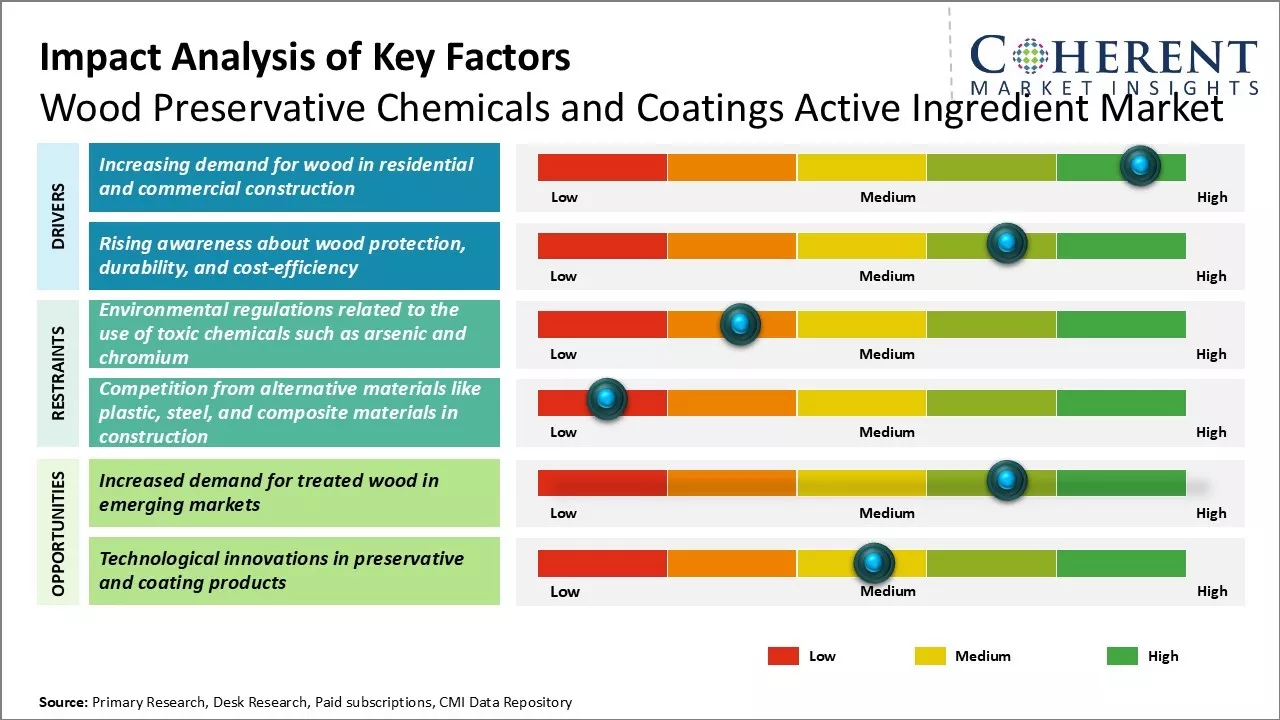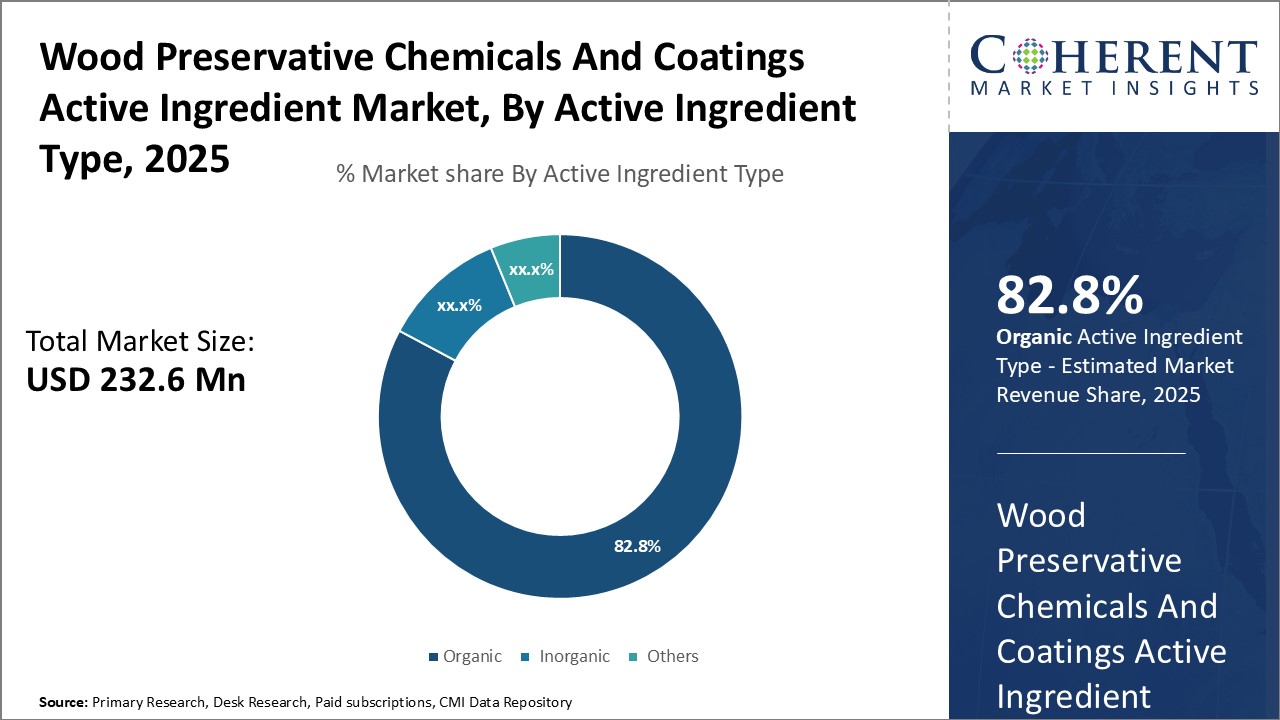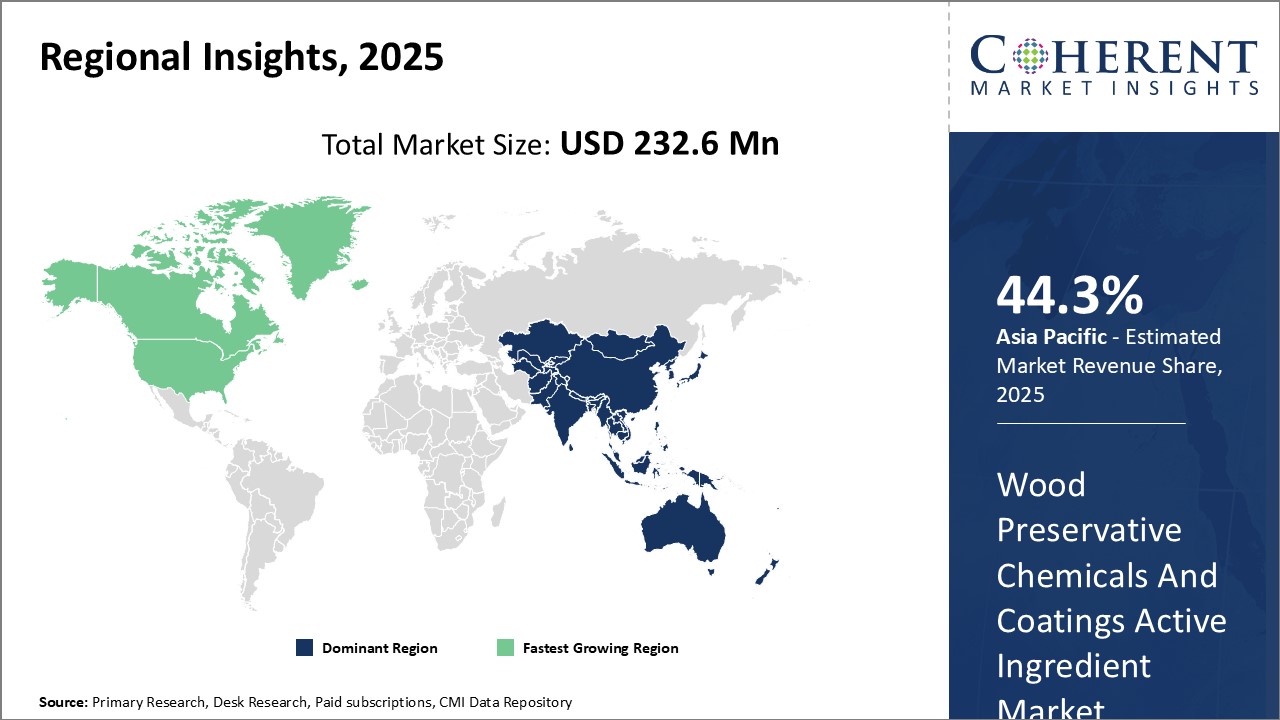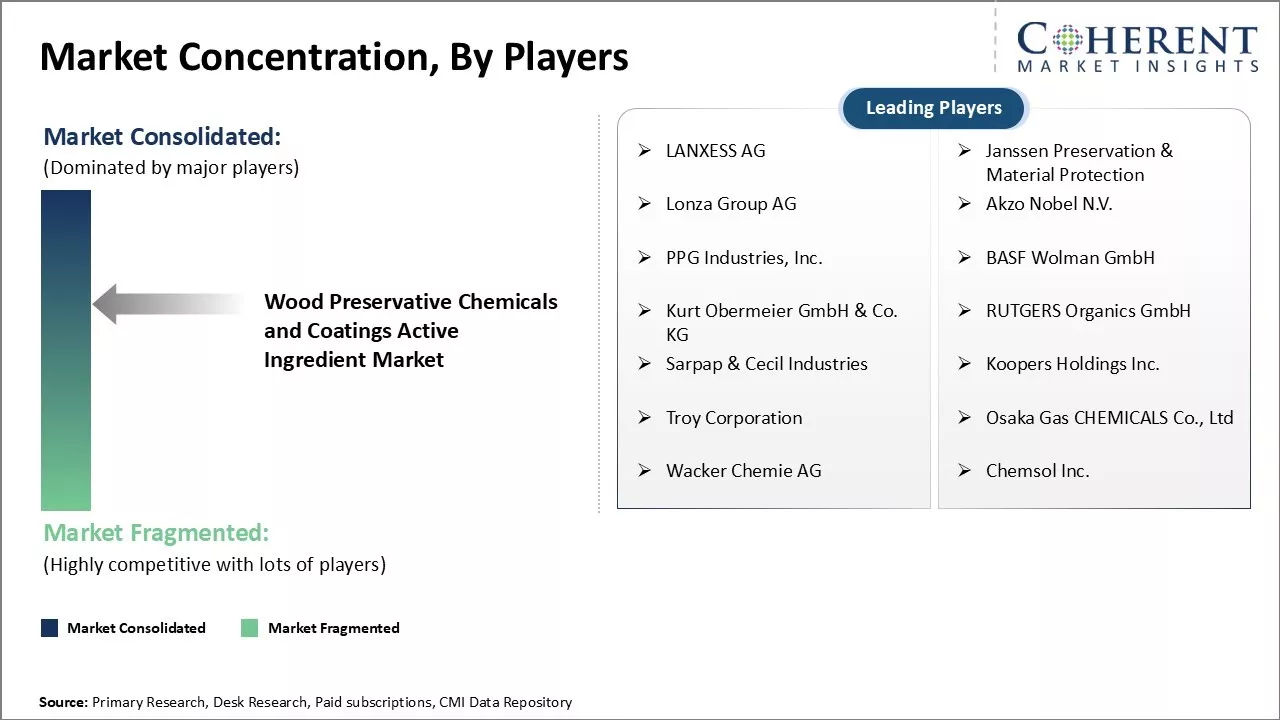The Wood Preservative Chemicals and Coatings Active Ingredient Market is estimated to be valued at USD 232.6 Mn in 2025 and is expected to reach USD 329.7 Mn by 2032, exhibiting a compound annual growth rate (CAGR) of 5.1% from 2025 to 2032. The market has been witnessing steady growth owing to rising construction activities and increasing spending on wood preservation globally.

Discover market dynamics shaping the industry: Download Free Sample
The wood preservative chemicals and coatings active ingredient market is expected to experience positive growth over the forecast period. Key factors such as growing infrastructure development and maintenance activities are expected to drive demand for wood preservative chemicals and coatings active ingredient. Additionally, regulations regarding the use of eco-friendly wood preservatives are anticipated to boost uptake.

Discover high revenue pocket segments and roadmap to it: Download Free Sample
Insights By Active Ingredient Type - Need for Sustainable Chemicals Drives Organic Segment Growth
In terms of Active Ingredient Type, Organic segment is estimated to hold 82.8% share of the market in 2025, owing to the increasing demand for eco-friendly wood preservative chemicals and coatings active ingredient. There is a rising awareness among consumers about the environment and health impacts of chemicals. Many users and specifiers are preferring organic-based wood preservative chemicals that use natural ingredients over synthetic or inorganic counterparts.
Insights By Use Class – UC 3 Outdoor Segment Dominates Due to Strong Demand for Outdoor Applications
In terms of Use Class, UC 3 Outdoor segment is estimated to hold 26.8% share of the market in 2025, owing to extensive use of wood preservative chemicals and coatings active ingredient in outdoor applications. Wood is heavily utilized in decking, fencing, railings and other exterior construction which are continuously exposed to harsh fungi and other degradation factors present outdoors.
Insights By Coating Type – User-friendliness Drives Paints and Stains Segment’s Dominance
In terms of Coating Type, Paints and Stains segment is estimated to hold 21.8% share of the market in 2025, due to their user-friendliness and aesthetically appealing nature. Paints and stains infused with preservatives allow the protection of wood from microbes and insects as well as impart decorative colors and finishes.

Need a Different Region or Segment? Download Free Sample
Dominating Region: Asia Pacific
Asia Pacific is expected to account for the greatest revenue share of 44.3% in 2025. Asia Pacific’s dominance in the wood preservative chemicals and coatings active ingredient market can be attributed to strong industry presence and availability of key raw materials. Stringent government regulations regarding wood treatment have also propelled growth.
Fastest-Growing Region: North America
North America region exhibits the fastest growth, fueled by rising construction activities and growing infrastructure development in countries like U.S. & Canada. Supportive government policies target wood replacement with durable and termite-resistant options.
Wood Preservative Chemicals and Coatings Active Ingredient Market Outlook for Key Countries
Extensive Wood Applications Drive Demand in the U.S.
The U.S. market is driven by high consumption for decking, fencing, and outdoor wood applications. Lonza Group AG borates and azole formulations dominate the protection of industrial and residential wood structures. The U.S. market is characterized by stringent building codes and high consumer awareness regarding treated wood. The construction sector, especially for residential and commercial buildings, is a major driver.
China's Expanding Market for Wood Preservatives and Biopesticides
China's market growth correlates to the nation's status as the largest construction market globally. BASF SE is investing in biopesticide research to address future regulations. China is one of the fastest-growing markets for wood preservatives, driven by rapid urbanization and infrastructure development. The increasing use of treated wood in residential and commercial buildings is supported by the country's expanding middle class. Additionally, China's manufacturing base for wood preservatives is significant, making it a key producer and consumer in the region.
Growth of India's Wood Preservative Market Amidst Urbanization and Environmental Awareness
Rapid urbanization and investments in public infrastructure are expanding India's treated wood demand. Government initiatives encourage preservation of agricultural assets and community buildings. India's wood preservative market is seeing growth due to the rise in residential construction and infrastructure projects. Wood is widely used in furniture and construction, particularly in rural areas. However, environmental awareness is still developing, with regulations.
Japan's Leadership in Wood Preservation through Nanotechnology and Innovation
Japan continues to lead in nanotechnology-based and polymer-bonded wood protection systems. Collaboration between academia and industry helps advance innovative coating techniques. In Japan, the market for wood preservatives and chemicals and coatings are driven by strict building codes that emphasize the protection of wood against insects, moisture, and fungal decay. Japan is known for its wooden architecture, particularly in residential buildings, and the market reflects a strong demand for high-quality preservative chemicals.
Brazil Market Growth Remains Driven by Infrastructure and Agricultural Needs
Brazil's market is supported by infrastructure projects and an agriculture-based economy that relies on farms and livestock facilities. Both importers and domestic formulators cater to specific regional requirements. Brazil's construction sector, driven by urbanization and government investment in infrastructure projects, is a major consumer of wood products. As wood is commonly used in both residential and commercial buildings, the need for protective coatings and preservatives to prevent decay, termite damage, and mold is high.

Get actionable strategies to beat competition: Download Free Sample
Top Strategies Followed by Wood Preservative Chemicals and Coatings Active Ingredient Market Players
Emerging Startups in the Wood Preservative Chemicals and Coatings Active Ingredient Market
Innovative technology startups are making waves. Terracoat is developing smart nano-sensors that monitor wood moisture levels, optimizing preservation treatment. Coat ink uses AI to formulate non-toxic coatings based on scanned wood grain/defects. Their customized solutions could reshape the wood preservative chemicals and coatings active ingredient industry.
Sustainable solutions will define future leaders. ecoStain employs recycled coffee grounds to create eco-friendly wood finishes. Greencoat uses food/plant wastes during production, reducing industrial pollution. Their novel waste-reducing innovations may encourage industry-wide change.
Some startups focus on niche demands. CraftCoat allows small shops to sample and order small coating batches suited to personalized jobs. Boreal Labs developed rapid-drying spruce coatings tailored for cold climates. Filling overlooked needs boosts startups' contributions.
Key Takeaways from Analyst
Wood Preservative Chemicals and Coatings Active Ingredient Market Report Coverage
| Report Coverage | Details | ||
|---|---|---|---|
| Base Year: | 2024 | Market Size in 2025: | USD 232.6 Mn |
| Historical Data for: | 2020 To 2024 | Forecast Period: | 2025 To 2032 |
| Forecast Period 2025 to 2032 CAGR: | 5.1% | 2032 Value Projection: | USD 329.7 Mn |
| Geographies covered: |
|
||
| Segments covered: |
|
||
| Companies covered: |
LANXESS AG, Janssen Preservation & Material Protection, Lonza Group AG, Akzo Nobel N.V., PPG Industries, Inc., BASF Wolman GmbH, Kurt Obermeier GmbH & Co. KG, RUTGERS Organics GmbH, Sarpap & Cecil Industries, Koopers Holdings Inc., Troy Corporation, Osaka Gas CHEMICALS Co., Ltd, Wacker Chemie AG, and Chemsol Inc. |
||
| Growth Drivers: |
|
||
| Restraints & Challenges: |
|
||
Uncover macros and micros vetted on 75+ parameters: Get instant access to report
Market Driver - Increasing demand for wood in residential and commercial construction
The wood preservative chemicals and coatings active ingredient market is expected to witness significant growth over the forecast period due to the increasing demand for wood from the construction industry. For example, as per data from the U.S. Environmental Protection Agency in 2020, the use of wood building products in constructing an average American home prevents approximately one metric ton of carbon dioxide from being released into the atmosphere annually as compared to other materials.
Market Challenge - Environmental regulations related to the use of toxic chemicals such as arsenic and chromium
One of the major challenges faced by the wood preservative chemicals and coatings active ingredient sector is the stringent environmental regulations related to the use of toxic chemicals such as arsenic and chromium. According to the statistics provided by the WHO in 2021, around 60% of wood preservative manufacturing firms reported losses or shutdown of many toxic chemical-based production facilities from 2015-2020 due to regulatory non-compliance issues and transition costs.
Market Opportunity-Increased Demand Opportunity in Emerging Markets
The wood preservative chemicals and coatings active ingredient market sees tremendous opportunity in the increased demand for treated wood from emerging economies. According to data from the Industry Research Report in March 2024, the construction industry in India grew by 7.1% in 2021, and estimates suggest the sector will continue growing at over 5-6% annually till 2025.
Share
Share
About Author
Yash Doshi is a Senior Management Consultant. He has 12+ years of experience in conducting research and handling consulting projects across verticals in APAC, EMEA, and the Americas.
He brings strong acumen in helping chemical companies navigate complex challenges and identify growth opportunities. He has deep expertise across the chemicals value chain, including commodity, specialty and fine chemicals, plastics and polymers, and petrochemicals. Yash is a sought-after speaker at industry conferences and contributes to various publications on topics related commodity, specialty and fine chemicals, plastics and polymers, and petrochemicals.
Missing comfort of reading report in your local language? Find your preferred language :
Transform your Strategy with Exclusive Trending Reports :
Frequently Asked Questions
Joining thousands of companies around the world committed to making the Excellent Business Solutions.
View All Our Clients